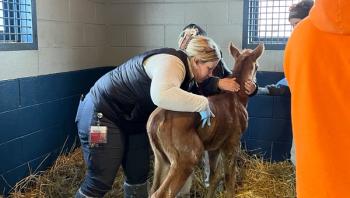
Approach to anemia (Proceedings)
Anemia is most simply characterized by reduced numbers of erythrocytes and/or decreased erythrocyte hemoglobin content.
Anemia: Anemia is most simply characterized by reduced numbers of erythrocytes and/or decreased erythrocyte hemoglobin content.
Dog: PCV < 38%
Cat: PCV < 24%
The nature (blood loss, hemolytic, or non-regenerative), duration and severity of anemia can defined by a few simple tests. History, physical and results of these tests will determine if further tests are required.
1. Packed Cell Volume (PCV):
Dog: 38% to 57%
Cat: 24% to 45%
More complete evaluation of red cell parameters, including hemoglobin, red cell count, mean corpuscular volume (MCV), mean corpuscular hemoglobin (MCH) and mean corpuscular hemoglobin concentration (MCHC) can be obtained by submitting blood to a diagnostic laboratory with an impedance (Coulter) type hematology analyzer. Recently, impedance type analyzers have also become available for in house use in veterinary practices. Ideally, the analyzer should be calibrated differently for cats and dogs, since feline red cells are significantly smaller than canine red cells. Otherwise, small feline erythrocytes may be below the analyzer range for red cells, and may mistakenly be miscounted as platelets. Some but not all of the above parameters can also be obtained from centrifuge-based hematology analyzers such as the Idexx QBC.
2. Total Serum Protein (TSP):
Dog: 5.8 to 7.6 g/dl
Cat: 6.0 to 8.0 g/dl
3. Examination of Direct Smear
Examination of air-dried, stained blood smear under high power.
4. Reticulocyte Count
Reticulocyte count quantitates erythrocyte regenerative response.
Automated analyzers that provide a RBC count (RBC x 106/µl) enable an absolute reticulocyte count to be calculated (reticulocytes/µl: normal is usually less than 60,000/µl).
Based on the results of the above tests, anemia can usually be separated into one of three simple classifications: hemorrhagic, hemolytic, or non-regenerative.
1. Hemorrhagic
(i) Acute Blood Loss
Acute, severe blood loss causes hypovolemic shock rather than anemia. Proportional loss of all major blood components means that initially both PCV and TSP remain normal. Volume expansion during recovery from hypovolemia progressively dilutes both PCV and TSP. Reflex splenic contraction, however, initially boosts red cell numbers, therefore TSP tends to drop before PCV. Decreased TSP occurs 1-4 hours after blood loss, and decreased PCV occurs after 12-24 hours. Loss of over 30% of blood volume in a single episode of hemorrhage can cause death due to hypovolemic shock. Patients that survive are therefore unlikely to have lost more than 30% of circulating red cells, and will not be severely anemic unless bleeding continues at a slower rate.
Erythrocyte regeneration (rising reticulocyte count) is not evident for 3-4 days. Acute blood loss can therefore initially mimic non-regenerative anemia. The subsequent regenerative response peaks at 5-7 days, although PCV may take up to 2-3 weeks to return to normal levels. TSP returns to normal levels more rapidly (1 week). Persistent anemia and hypoproteinemia suggest ongoing blood loss.
Diagnostic Features
Anemia will be regenerative after 3-5 days, featuring anisocytosis, polychromasia and sometimes nucleated red cells on examination of stained blood smears, with an increased corrected reticulocyte count. For the first week after a bleeding episode, there may also be hypoproteinemia
Further Investigation
Evaluate hemostasis, via tests such as platelet count, prothrombin time (PT), partial thromboplastin time (PTT), activated clotting time (ACT), and buccal mucosa bleeding time (BMBT). Investigate potential gastrointestinal, urinary and body cavity hemorrhage via fecal occult blood and endoparasitic flotation, urine dipstick and sedimentation, and thoracic and abdominal radiographs respectively.
(ii) Chronic Blood Loss
Regardless of the underlying cause, small animals respond to chronic anemia in a predictable fashion. Reduced oxygenation of the kidneys secondary to anemia stimulates erythropoietin release, which in turn stimulates the marrow to increase red cell production and release. Small animals also eventually compensate for anemia by increasing levels of erythrocyte 2,3-diphosphoglycerate (2,3-DPG), which improves the release of oxygen from hemoglobin into the tissues. Patients with chronic anemia can compensate remarkably well, and may only exhibit obvious clinical signs when anemia becomes extreme (PCV below 15% or even 10%). The signs of anemia reflect both insufficient hemoglobin to oxygenate tissues (pale mucous membranes, lethargy, weakness) and the predictable compensatory responses of the sympathetic nervous system to tissue hypoxia (tachypnea, tachycardia and, frequently, bounding pulses). Blood loss anemia is typically regenerative. Chronic external hemorrhage (most commonly GI loss), however, may eventually cause iron deficiency and non-regenerative anemia.
Diagnostic Features
Initially, anemia will be regenerative, featuring anisocytosis, polychromasia, reticulocytosis and sometimes nucleated red cells, with possible hypoproteinemia. Eventually, anemia will become poorly regenerative, microcytic and hypochromic.
Further Investigation
Meticulously investigate hemostatic adequacy and potential gastrointestinal, urinary and cavity hemorrhage as for patients with acute anemia. Evaluate iron status by measuring serum iron, total iron-binding capacity, ferritin and marrow iron stores. Markedly decreased marrow iron stores are suggestive of iron deficiency in dogs, but may sometimes be observed in normal cats. The practitioner should always be able to confidently confirm or exclude acute or chronic blood loss as the cause of anemia using standard diagnostic tests.
2. Hemolytic
Hemolysis destroys only erythrocytes, so blood volume, leukocytes, platelets and serum protein remain normal. As with acute blood loss, acute hemolytic anemia will appear to be non-regenerative until the marrow responds in 3-5 days. Iron deficiency anemia does not occur because there is no external blood loss. Hemoglobin released from red cells is metabolized by tissues into unconjugated bilirubin (which circulates bound to proteins), and is then efficiently taken up by hepatocytes, conjugated and excreted in bile. Only massive, acute hemolysis overwhelms this process.
Causes of Hemolysis: Immune-mediated hemolytic anemia (IMHA)
Microangiopathic hemolysis (DIC, hemangiosarcoma)
Heinz body hemolytic anemia (onion poisoning, acetaminophen)
Zinc-induced hemolytic anemia
Inherited erythrocyte defects (pyruvate kinase deficiency in the Basenji)
In cats, also consider: FeLV-associated hemolytic anemia
Hemobartonellosis (causative organism Mycoplasma hemofelis)
Severe hypophosphatemia
Intravascular hemolysis releases hemoglobin directly into the circulation. Hemoglobin binds to plasma haptoglobin, which prevents it from spilling into the urine. Massive hemoglobin release during severe intravascular hemolysis overwhelms haptoglobin binding, causing hemoglobinemia and hemoglobinuria. Since extravascular hemolysis does not release hemoglobin into the circulation, hemoglobinemia and hemoglobinuria do not occur. Furthermore, jaundice occurs only during acute crises. Hemolysis in small animals is usually extravascular, and rarely causes hemoglobinemia/hemoglobinuria. Extravascular hemolysis is commonly subacute, and if liver function is normal will not cause persistent jaundice.
Diagnostic Features of Hemolytic Anemia
Hemolytic anemia will become strongly regenerative after 3-5 days, with anisocytosis, polychromasia, reticulocytosis and sometimes nucleated red cells. Unlike anemia due to blood loss, serum protein concentrations will remain normal. Bilirubinemia and bilirubinuria indicate acute, severe hemolytic anemia (intravascular or extravascular), while hemoglobinemia and hemoglobinuria indicate intravascular hemolysis. The presence of many spherocytes (small, spherical erythrocytes) on examination of a blood smear specifically indicates that the hemolysis is immune-mediated.
Further Investigation
Specific tests for IMHA include slide agglutination and the Coombs test. Non-immunologic causes of hemolytic anemia may be further investigated by collecting a complete history (potential ingestion of zinc, onions or medication), and performing thoracic and abdominal radiographs to search for neoplasia or metallic objects within the gastrointestinal tract. In the cat, FeLV testing and examination of serial blood smears for Mycoplasma hemofelis should also be considered.
3. Non-Regenerative Anemia
Circulating red cell life-span in small animals is about 2-3 months. Non-regenerative anemia therefore typically develops gradually as the diseased marrow fails to replace aging erythrocytes. Compensatory mechanisms are well established, enabling patients to cope despite severe anemia.
Causes of Non-Regenerative Anemia
Many of the systemic disorders that cause non-regenerative anemia only produce mild sub-clinical anemia, whereas primary bone marrow disorders typically cause moderate to severe anemia.
Diagnostic Features
Typical non-regenerative anemia features minimal anisocytosis or polychromasia, and has a low reticulocyte count. Erythrocytes usually appear normal (normocytic, normochromic anemia). Serum protein is usually normal. Iron deficiency anemia will typically be microcytic and hypochromic. Bone marrow disorders often cause concurrent leukopenia and thrombocytopenia.
Further Investigation
Systemic illnesses causing secondary depression of red cell production can usually be identified by history, physical examination and results of hematology and biochemistry. Mild to moderate non-regenerative anemia is most commonly anemia of chronic disease, associated with such processes as chronic inflammatory diseases, infection and neoplasia. Serological testing may be indicated in patients with non-regenerative anemia, particularly for retroviruses in cats (leukemia and immunodeficiency viruses) and Ehrlichia canis in dogs. Bone marrow analysis is essential for establishing a definitive diagnosis in patients with non-regenerative anemia due to primary marrow disorders.
Treatment of Anemia
Treatment of Acute and Chronic Blood Loss
The most effective means of treating anemia due to hemorrhage is to identify and remove the underlying cause.
Surgery: Trauma to major vessels or vascular organs
Refractory epistaxis (ligation of the internal carotid artery)
Bleeding neoplasms (hemangiosarcoma)
Focal gastrointestinal hemorrhage (tumors, large ulcers)
Unilateral renal hemorrhage
Medical Therapy: Gastrointestinal ulceration
Ectoparasites (fleas, lice)
Endoparasites (hookworm)
Coagulopathies
Volume Replacement
Since hypovolemic shock is the major consequence of acute severe hemorrhage, prompt and vigorous volume replacement is the treatment of choice.
Volume replacement should be administered to effect. Initial doses may be repeated if hypovolemia persists or bleeding continues.
Transfusion
Moderate to severe anemia without hypovolemia may occur in patients with acute severe hemorrhage following vigorous volume replacement therapy, and in patients with chronic ongoing blood loss. Transfusion is indicated in such patients.
Iron Supplementation
Iron deficiency anemia is treated by removing the underlying cause of blood loss, administering oral Ferrous Sulfate at 4-6 mg of iron/kg/daily for several months, and blood transfusion if necessary.
Treatment of Hemolytic Anemia
As with blood loss anemia, the most effective means of treating hemolytic anemia is to identify and treat the primary cause.
Surgery
Zinc foreign bodies within the gastrointestinal tract
DIC due to operable neoplasia (e.g. splenic hemangiosarcoma)
Medical Therapy
Immune-mediated hemolysis (immunosuppressive therapy)
Disseminated intravascular coagulation (heparin, plasma)
Mycoplasma hemofelis (tetracyclines)
Acute ehrlichiosis (tetracyclines)
Hypophosphatemia (phosphorous supplementation)
Treatment of Immune-Mediated Hemolytic Anemia
Initial therapy usually consists of Prednisolone at immunosuppressive doses. Concurrent Azathioprine, Cyclosporine or Cyclophosphamide should be considered when anemia is acute and severe or slide agglutination is positive. Response to standard therapy may be delayed for several weeks. In the meantime, life-threatening anemia may require blood transfusion, Oxyglobin, plasmapheresis or high-dose human immunoglobulins. Chronic refractory anemia may be treated with oral Danazol or splenectomy.
Treatment of Hemolytic Anemia in the Cat
Treatment of immune-mediated hemolytic anemia in the cat is similar to treatment in the dog. Immune-mediated hemolytic anemia in cats, however, is usually secondary to either feline leukemia virus or hemobartonellosis (Mycoplasma hemofelis). FeLV-associated hemolytic anemia is indistinguishable from immune-mediated hemolytic anemia. Cats with hemolytic anemia should be tested for FeLV, and positive cats should receive standard immunosuppressive therapy. FeLV-positive cats often initially respond well to therapy, although long-term prognosis is poor. Cats with Mycoplasma hemofelis typically present with recurring episodes of hemolytic anemia. During anemic crises, organisms may not be apparent (affected erythrocytes are sequestered in the spleen). Organisms reappear on red cells during remission of anemia, and will be discovered by serial blood smears. Cats with hemolytic anemia should receive oral tetracyclines, even if organisms are not seen on initial blood smears. Concurrent immunosuppressive therapy in cats with Mycoplasma hemofelis is not contraindicated. In fact, since anemia due to Mycoplasma hemofelis has an immune-mediated component, glucocorticoids are indicated during acute crises.
Transfusion in Patients with Hemolytic Anemia
Cage rest and standard medical therapy (e.g. immunosuppressive drugs) are successful in most dogs and cats with non-life-threatening hemolytic anemia. Transfused red cells have a short life-span in patients with hemolytic anemia. Blood transfusions may in theory increase the rate of hemolysis ('add fuel to the fire'). Transfusion is however indicated if the patient is significantly affected by anemia (weakness, stupor, or dyspnea), and may be life-saving in such circumstances. Hematocrit alone is a poor guide, as a stable patient does not require transfusion despite an extremely low PCV (10% or less). Since patients with hemolytic anemia have normal blood volume and protein levels, packed red cells are preferable to whole blood. Oxyglobin may also be useful for treatment of acute crises. Multiple whole blood transfusions in patients with severe hemolytic anemia can cause volume overload. Since cross-matches will often be positive in patients with hemolytic anemia, blood group compatible donors should be used if blood typing is available.
Supportive Therapy
Since patients with hemolytic anemia have a normal blood volume, fluid therapy is of no benefit and may contribute to volume overload.
The severely anemic patient can be supported with oxygen supplementation. Hemoglobin oxygen saturation is however already near maximal, and supplementation with oxygen therefore increases saturation only minimally. Oxygen supplementation is also laborious and expensive.
Treatment of Non-Regenerative Anemia
Systemic Disorders Causing Anemia
The best method of treating non-regenerative anemia secondary to systemic disorders is to eliminate the underlying etiology, for example discontinuing medications given prior to the development of anemia, and neutering patients with hyperestrogenism due to gonadal tumors.
Iron Deficiency Anemia
Iron deficiency anemia is best treated by removing the primary cause of chronic blood loss and administering oral Ferrous Sulfate at a dose rate of 4-6 mg of iron/kg/daily for several months.
Chronic renal failure
The anemia associated with chronic renal failure is most effectively (although very expensively) treated with recombinant erythropoietin. Human erythropoietin is reported to be initially effective in small animals with renal failure, but often becomes less effective as antibodies develop to the foreign protein. Canine or feline erythropoietin can be given to dogs and cats, respectively, indefinitely without inducing antibodies, but is unfortunately currently not available.
Treatment of the anemia of chronic renal failure with various androgens has been traditionally recommended, but is often only minimally effective. Generally androgens must be given for several months before a significant increase in PCV is detected.
Primary Bone Marrow Disorders
Pure red cell aplasia and aplastic anemia are forms of marrow failure that in the past have been regarded as incurable without marrow transplantation. More recently, some cases of pure red cell aplasia and aplastic anemia have been demonstrated to be unusual immune-mediated diseases, with antibodies being produced against various hematopoietic precursors within the marrow. Such patients may respond to immunosuppressive therapy.
Oral immunosuppressive therapy with glucocorticoids and Azathioprine or Cyclosporine (same dosage regimes as used for immune-mediated hemolytic anemia) is indicated in stable patients with pure red cell aplasia and aplastic anemia. Detectable increases in hematocrit may be delayed for several months. Serial analyses of marrow cytology or histopathology (every few weeks) may be used to monitor early responses to immunosuppressive therapy. Despite isolated anecdotal reports of successful responses to chemotherapy or radiotherapy, marrow neoplasia is typically an incurable disease. Myelofibrosis is similarly typically incurable.
Transfusion in Patients with Non-Regenerative Anemia
Since both recipient and donor erythrocytes in patients with non-regenerative anemia typically have a normal circulating life-span, transfusion is an effective method of supportive treatment. A single blood transfusion may stabilize an anemic patient for several months. Since patients with non-regenerative anemia have normal blood volume and serum protein concentrations, packed red cells are preferable to whole blood. Oxyglobin, because it only has a clinical effect that lasts a few days, is rarely indicated in animals with non-regenerative anemia.
The ideal transfusion end-point is probably the conversion of severe anemia into mild to moderate anemia (PCV of 25-30%). Endogenous erythropoietin release may fail to be stimulated if an anemic patient is transfused to a packed cell volume of over 30%, with a consequent delay in the recovery of normal hematopoiesis.
Refractory non-regenerative anemia may necessitate repeat blood transfusions every two to three months. Multiple transfusions over a prolonged period of time greatly increase the risk of transfusion reactions. Even subtle incompatibilities will decrease the circulating life span of donor erythrocytes, necessitating progressively more frequent blood transfusions in order to maintain an adequate hematocrit. Cross-matching should always be performed prior to transfusion in patients receiving additional blood transfusions more than one week after the initial transfusion was administered.
Newsletter
From exam room tips to practice management insights, get trusted veterinary news delivered straight to your inbox—subscribe to dvm360.





